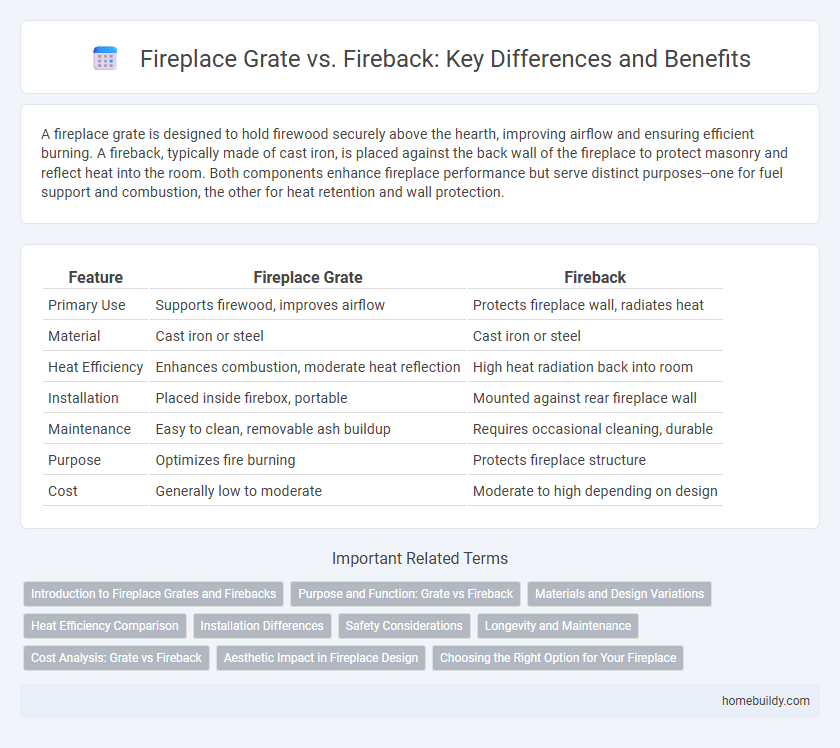A fireplace grate is designed to hold firewood securely above the hearth, improving airflow and ensuring efficient burning. A fireback, typically made of cast iron, is placed against the back wall of the fireplace to protect masonry and reflect heat into the room. Both components enhance fireplace performance but serve distinct purposes--one for fuel support and combustion, the other for heat retention and wall protection.
Table of Comparison
| Feature | Fireplace Grate | Fireback |
|---|---|---|
| Primary Use | Supports firewood, improves airflow | Protects fireplace wall, radiates heat |
| Material | Cast iron or steel | Cast iron or steel |
| Heat Efficiency | Enhances combustion, moderate heat reflection | High heat radiation back into room |
| Installation | Placed inside firebox, portable | Mounted against rear fireplace wall |
| Maintenance | Easy to clean, removable ash buildup | Requires occasional cleaning, durable |
| Purpose | Optimizes fire burning | Protects fireplace structure |
| Cost | Generally low to moderate | Moderate to high depending on design |
Introduction to Fireplace Grates and Firebacks
Fireplace grates are essential metal frameworks designed to hold firewood and improve airflow, enhancing combustion efficiency and heat distribution. Firebacks, typically made of cast iron and placed against the back wall of the fireplace, protect the masonry and reflect heat into the room. Both components serve distinct roles in optimizing fireplace performance and longevity, with grates focusing on fuel support and firebacks on heat retention and structural preservation.
Purpose and Function: Grate vs Fireback
A fireplace grate elevates logs to improve airflow and combustion efficiency, ensuring a cleaner and hotter fire. A fireback, positioned at the rear of the fireplace, protects the wall from heat while reflecting radiant heat back into the room. Grates prioritize fuel support and air circulation, whereas firebacks focus on heat retention and structural protection.
Materials and Design Variations
Fireplace grates are typically constructed from heavy-duty cast iron or steel, designed to hold logs securely and allow air circulation for optimal combustion. Firebacks, often made from cast iron or wrought iron, serve as protective backplates and heat reflectors, featuring various ornamental or plain designs that enhance aesthetic appeal and durability. The design variations in grates emphasize functionality and airflow, while firebacks focus on heat retention and decorative elements.
Heat Efficiency Comparison
A fireplace grate enhances heat efficiency by promoting better airflow and combustion, allowing wood to burn more completely and radiate heat into the room. In contrast, a fireback primarily functions to protect the back wall of the fireplace and reflects heat outward, but it does not improve airflow or fuel burning efficiency. Combining both a grate and fireback optimizes heat output, with the grate improving fuel efficiency and the fireback maximizing heat radiation.
Installation Differences
Fireplace grates are installed within the firebox to elevate logs, improving airflow and combustion efficiency. Firebacks are positioned against the rear wall of the fireplace, often requiring secure mounting or adhesive to protect and reflect heat. Installation of grates is typically simpler, involving placement without permanent fixtures, whereas firebacks demand careful alignment and fastening for optimal heat distribution and durability.
Safety Considerations
Fireplace grates enhance safety by securely holding logs in place, allowing better airflow and reducing the risk of embers falling onto the hearth. Firebacks provide a heat-resistant barrier that protects the wall from excessive heat and prevents potential fire hazards. Using both together maximizes safety by stabilizing the firewood and shielding surrounding structures from heat damage.
Longevity and Maintenance
A fireplace grate, made of heavy-duty steel, offers excellent durability and requires minimal maintenance, as it efficiently holds logs to promote better airflow and combustion. Firebacks, typically constructed from cast iron, provide long-lasting protection for the back wall of the fireplace but may need occasional cleaning to prevent rust and maintain their heat-retention properties. While both enhance fireplace performance, fireplace grates generally demand less upkeep and offer superior longevity due to their robust design and resistance to deformation under high temperatures.
Cost Analysis: Grate vs Fireback
Fireplace grates typically cost between $50 and $150, offering a durable support for burning logs and improved airflow, which enhances combustion efficiency. Firebacks, made of cast iron, range from $100 to $300 and protect the fireplace wall while radiating heat into the room, adding lasting value but at a higher upfront price. Choosing between a grate and a fireback depends on budget priorities and whether heat distribution or log support is the primary goal.
Aesthetic Impact in Fireplace Design
A fireplace grate enhances the aesthetic impact by showcasing a dynamic arrangement of firewood that emphasizes warmth and movement within the hearth. In contrast, a fireback serves as a decorative metal plate positioned at the rear of the fireplace, reflecting heat while adding ornate design elements that create visual depth. Combining both elements can balance functionality with style, elevating the overall ambiance and architectural appeal of the fireplace.
Choosing the Right Option for Your Fireplace
A fireplace grate enhances airflow and ensures efficient burning by holding logs off the floor, while a fireback protects the rear wall of the fireplace from heat damage and radiates warmth back into the room. Choosing the right option depends on your fireplace's design and heating needs; grates are ideal for optimizing combustion and airflow, whereas firebacks are better for heat retention and structural protection. Consider factors such as fireplace size, material durability, and your desired heat distribution to select the most effective accessory for your setup.
Fireplace grate vs Fireback Infographic

 homebuildy.com
homebuildy.com